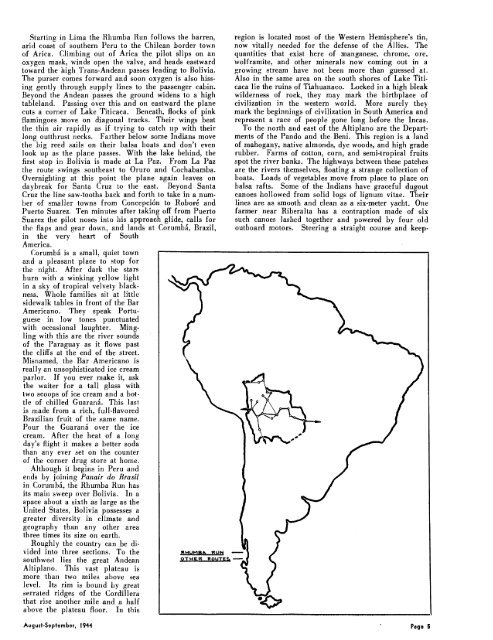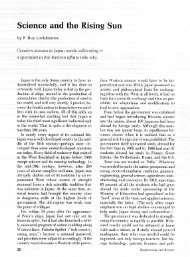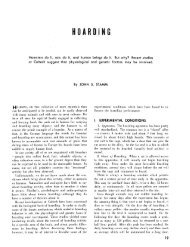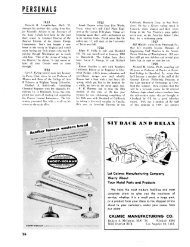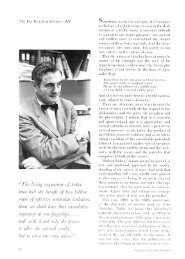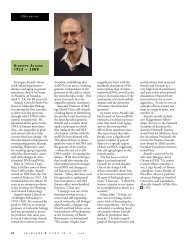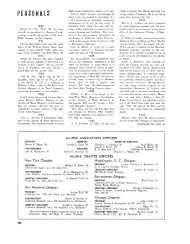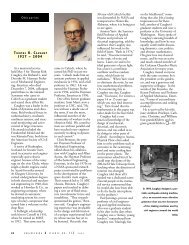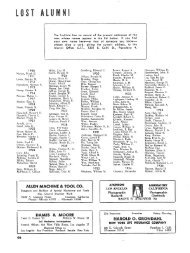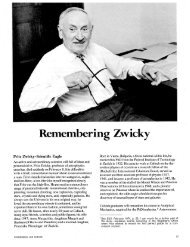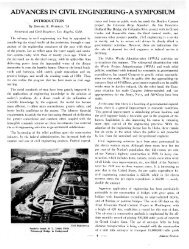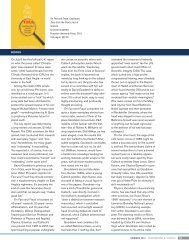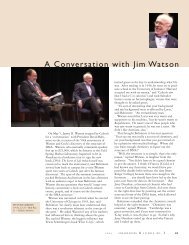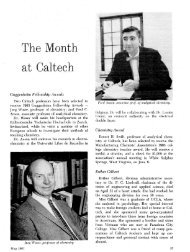Rhumba Run—Part 1 - Engineering & Science
Rhumba Run—Part 1 - Engineering & Science
Rhumba Run—Part 1 - Engineering & Science
You also want an ePaper? Increase the reach of your titles
YUMPU automatically turns print PDFs into web optimized ePapers that Google loves.
Starting in Lima the <strong>Rhumba</strong> Run follows the barren.<br />
arid coast of southern Peru to the Chilean border town<br />
of Arica. Climbing out of Arica the pilot slips on an<br />
oxygen mask, winds open the valve, and heads eastward<br />
toward the high Trans-Andean passes leading to Bolivia.<br />
The purser comes forward and soon oxygen is also hiss-<br />
ing gently through supply lines to the passenger cabin.<br />
Beyond the Andean passes the ground widens to a high<br />
tableland. Parsing over this and on eastward the plane<br />
cuts a corner of Lake Titicaca. Beneath, flocks of pink<br />
flamingoes move on diagonal tracks. Their wings beat<br />
the thin air rapidly as if trying to catch up with their<br />
long outthrust necks. Farther below some Indians move<br />
the hig reed sails on their balsa boats and don't even<br />
look up as the plane passes. With the lake behind, the<br />
first ston in Bolivia is made at La Paz. From La Paz<br />
the route swings southeast to Oruro and Cochabamba.<br />
Overnigliting at this point the plane again leaves on<br />
daybreak for Santa Cruz to the east. Beyond Santa<br />
Cruz the line saw-tooths back and forth to take in a num-<br />
ber of smaller towns from Conception to Robore and<br />
Puerto Suarez. Ten minutes after taking off from Puerto<br />
Suarez the pilot noses into his approach glide, calls for<br />
the flaps and gear down, and lands at Corumbh, Brazil,<br />
in the very heart of South<br />
America.<br />
Corumbh is a small, quiet town<br />
and a pleasant place to stop for<br />
the night. After dark the stars<br />
burn with a winking yellow light<br />
in a sky of tropical velvety black-<br />
ness. Whole families sit at little<br />
sidewalk tables in front of the Bar<br />
Arnericano. They speak Portu-<br />
guese in low tones punctuated<br />
with occasional laughter. Ming-<br />
ling with this are the river sounds<br />
of the Paraguay as it flows past<br />
the cliffs at the end of the street.<br />
Misnamed. the Bar Arnericano is<br />
really an unsophisticated ice cream<br />
parlor. If you ever make it, ask<br />
the waiter for a tall glass with<br />
two scoops of ice cream and a bot-<br />
tle of chilled Guaranh. This last<br />
is made from a rich, full-flavored<br />
Brazilian fruit of the same name.<br />
Pour the Guaranh over the ice<br />
cream. After the heat of a long<br />
day's flight it makes a better soda<br />
than any ever set on the counter<br />
of the corner drug store at home.<br />
Although it begins in Peru and<br />
ends by joining Panair do Brad<br />
in Corumbh, the <strong>Rhumba</strong> Run has<br />
its main sweep over Bolivia. In a<br />
space about a sixth as large as the<br />
United States. Bolivia possesses a<br />
greater diversity in climate and<br />
geography than any other area<br />
three times its size on earth.<br />
Roughly the country can be di-<br />
vided into three sections. To the<br />
southwer-t lies the great Andean<br />
Altiplano. This vast plateau is<br />
more than two miles above sea<br />
level. Its rim is hound Ly great<br />
serrated ridges of the Cordillera<br />
that rise another mile and a half<br />
above the plateau floor. In this<br />
region is located most of the Western Hemisphere's tin,<br />
now vitally needed for the defense of the Allies. The<br />
quantities that exist here of manganese, chrome, ore,<br />
wolframite, and other minerals now coming out in a<br />
growing stream have not been more than guessed at.<br />
Also in the same area on the south shores of Lake Titi-<br />
caca lie the ruins of Tiahuanaco. Locked in a high bleak<br />
wilderness of rock, they may mark the birthplace of<br />
civilization in the western world. More surely they<br />
mark the beginnings of civilization in South America and<br />
represent a race of people gone long before the Incas.<br />
To the north and east of the Altiplano are the Depart-<br />
ments of the Pando and the Beni. This region is a land<br />
of mahogany, native almonds, dye woods, and high grade<br />
rubber. Farms of cotton, corn, and semi-tropical fruits<br />
spot the river banks. The highways between these patches<br />
are the rivers themselves, floating a strange collection of<br />
boats. Loads of vegetables move from place to place on<br />
balsa rafts. Some of the Indians have graceful dugout<br />
canoes hollowed from solid logs of lignum vitae. Their<br />
lines are as smooth and clean as a six-meter yacht. One<br />
farmer near Riberalta has a contraption made of six<br />
such canoes lashed together and powered by four old<br />
outboard motors. Steering a straight course and keep-<br />
August-September, 1944 Page 5


